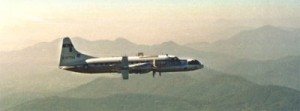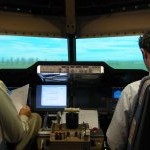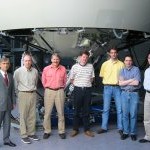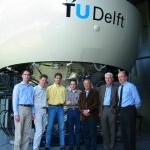During the early 1990’s Boeing undertook a series of piloted simulation experiments investigating the longitudinal handling qualities of very large transport aircraft. The highest fidelity research simulators available were used for these experiments, the results of which yielded an extensive database that was subsequently used for handling qualities criteria development. As part of a cooperative research agreement, these experiments have just been repeated on the TU Delft SIMONA Research Simulator (SRS).
The Generic Large Transport
 Having recently developed the MD-11 and C-17 transport aircraft in Long Beach, California, Boeing (then McDonnell Douglas) perceived the need for validated handling qualities criteria for aircraft of their size and larger.
Having recently developed the MD-11 and C-17 transport aircraft in Long Beach, California, Boeing (then McDonnell Douglas) perceived the need for validated handling qualities criteria for aircraft of their size and larger.
To develop the required handling qualities criteria and design guidance, a research aircraft model was developed, the Generic Large Transport (GLT). The GLT was developed specifically for handling qualities research and was based on conceptual designs of the time. The model incorporated several advanced technologies, in the areas of materials, aerodynamics, flight controls and flight deck technologies. With a takeoff weight of around one million pounds, the aircraft would carry 500 passengers as far as 8,000 nautical miles at a nominal cruise Mach number of 0.85 and altitude of 36,000 feet.
A matrix of twenty-five configurations was produced by varying the longitudinal axis properties of interest around the GLT aircraft model. These properties included pitch acceleration sensitivity (n/±), short period frequency (Ésp), equivalent time delay (Tsp) and pitch sensitivity.
The TIFS and VMS Experiments
 The twenty-five GLT configurations were evaluated in the USAF Total In-Flight Simulator (TIFS) by three experienced test pilots. Capable of providing high fidelity motion in all six degrees-of-freedom (roll, pitch, yaw, surge, sway and heave), and real-World visual cues, the TIFS is considered the highest fidelity simulator available for handling qualities research of large aircraft. The results of the evaluations were culled into a highly validated, extensive database of large transport aircraft longitudinal handling qualities. This database was subsequently used to appraise and modify existing handling qualities criteria.
The twenty-five GLT configurations were evaluated in the USAF Total In-Flight Simulator (TIFS) by three experienced test pilots. Capable of providing high fidelity motion in all six degrees-of-freedom (roll, pitch, yaw, surge, sway and heave), and real-World visual cues, the TIFS is considered the highest fidelity simulator available for handling qualities research of large aircraft. The results of the evaluations were culled into a highly validated, extensive database of large transport aircraft longitudinal handling qualities. This database was subsequently used to appraise and modify existing handling qualities criteria.
 The same three test pilots repeated their evaluations of twelve of the GLT configurations in the NASA Ames Research Center’s Vertical Motion Simulator (VMS). The VMS is capable of large motion displacements and is considered the highest fidelity ground based simulator available for handling qualities research.
The same three test pilots repeated their evaluations of twelve of the GLT configurations in the NASA Ames Research Center’s Vertical Motion Simulator (VMS). The VMS is capable of large motion displacements and is considered the highest fidelity ground based simulator available for handling qualities research.
Comparison of the results from the TIFS and VMS evaluations identified differences. It was hypothesized that these differences were due to different implementations of the experiment in the two facilities. These differences included the motion cues, visual cues and touchdown cues.
The SRS Experiments
 A series of three GLT experiments were performed on the SRS between July 2002 and July 2003. These were the first handling qualities experiments performed on the SRS, and concerned the replication of the previous GLT experiments performed on the TIFS and VMS. The experiments served two purposes. First, they provided a calibration of SIMONA against the more mature TIFS and VMS, and so a means to assess the utility of SIMONA for future handling qualities research. Second, the experiments were an opportunity to investigate the differences between the results obtained from the TIFS and VMS experiments.
A series of three GLT experiments were performed on the SRS between July 2002 and July 2003. These were the first handling qualities experiments performed on the SRS, and concerned the replication of the previous GLT experiments performed on the TIFS and VMS. The experiments served two purposes. First, they provided a calibration of SIMONA against the more mature TIFS and VMS, and so a means to assess the utility of SIMONA for future handling qualities research. Second, the experiments were an opportunity to investigate the differences between the results obtained from the TIFS and VMS experiments.
The first experiment in July and August 2002 concentrated on the implementation of the GLT model and evaluation tasks in the SRS.
The second experiment in April and May 2003 comprised two main objectives. First, tuning and validation of the GLT model and evaluation task in the SRS. This was followed by the optimization of the motion response of the SRS for the GLT experiments. Experienced test pilots from Boeing and NASA Ames participated in this experiment.
 The third experiment was performed in June and July 2003. This experiment was a replication of those previously performed on the TIFS and VMS, using the same three test pilots, two from Boeing in Long Beach, the third from the NASA Langley Research Center, Norfolk, Virginia. Initial examination of the results from the SRS evaluations suggest that they correlate with those from the TIFS and VMS, and that they go some way to explaining the differences in the results from those two facilities. Further analysis of the results has been performed and was presented in August 2004 (see reference [2]).
The third experiment was performed in June and July 2003. This experiment was a replication of those previously performed on the TIFS and VMS, using the same three test pilots, two from Boeing in Long Beach, the third from the NASA Langley Research Center, Norfolk, Virginia. Initial examination of the results from the SRS evaluations suggest that they correlate with those from the TIFS and VMS, and that they go some way to explaining the differences in the results from those two facilities. Further analysis of the results has been performed and was presented in August 2004 (see reference [2]).



